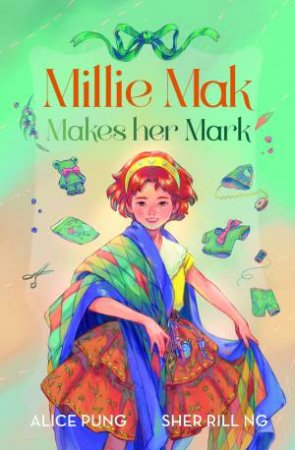Millie Mak makes her mark by Alice Pung and Sher Rill Ng

Millie Mak makes her mark is the final title in the series about Millie Mak a pre-teenager and a clever maker and problem-solver. This final book is divided into two stories. Each story is followed by step-by step instructions for making the crafty projects that Millie and her friends made in the previous story. The central female protagonist Millie Mak is an overall wonderful girl who not only creates useful, environmentally friendly things by redesigning, reusing and recycling but who also is a very good and wise friend.
Alice Pung (OAM)an award winning Melbourne-based author has in Millie Mak makes her mark (as in her other works) written a story which is sensitive and inclusive about race, culture, various family structures and financial struggle. The characters in the series are representative of a variety of situations especially the experience of the new arrival to Australia. Friendship and group endeavour seems to be the solution to many a social problem and there is much wisdom displayed especially from Ahma (grandma) who notably was very plain speaking when Veesa complained about having to work for her mother (who was a low paid, fast-fashion seamstress). "Girls like you do not have the luxury of protest," Ahma stated. "Not if you want to be educated...how many millions of girls in the world would love even just a week of that Swedish girl's (Greta Thunberg) education?" The friendships created amongst families of disparate backgrounds through the girls' efforts is heart-warming.
Millie Mak makes her mark, like the rest of the series, is really a compilation of small adventures rather than a rich narrative. Reminiscent of the Milly Molly Mandy series (Joyce Lankester Brisley), Millie Mak is like an older Milly Molly Mandy. Millie Mak herself is inspired by the adventures of Enid Blyton's The Famous Five and The Secret Seven and the Narnia children. The chapters are episodic rather than following the structural narrative of a novel. Little stories like the development of a small project for dying old material to make a quilt for Grandad who has had a stroke are procedural and written using simple every day retrievable vocabulary. After the girls have produced a project and solved a few social problems along the way the text is followed by procedures for activities including making dye, learning how to sew using different stitches and making salt-dough ornaments and hand-towel teddies.
Mille Mak and her friends help each other throughout with social and emotional problems and even with worrying menstruation issues. This is all very useful for the pre-teenage cohort of readers. Quite obviously the Millie Mak series is for girls. While seemingly a simple story about girls working together and starting a business, there are many underlying themes. Reducing our environmental footprint, especially in terms of the fashion industry is paramount. Of importance too is being proactive, working cooperatively in a team, taking responsibility and thinking of the other. Pung encourages thinking about what causes people to behave in particular ways and not taking people at face value but rather knowing that each person carries a backstory.
Millie Mak makes her mark is published by HarperCollins Publishers Australia and New Zealand in textured hardback form with a delightful softly shaded cover and matching patchwork end papers. The cover artist is Sher Rill Ng a Melbourne-based illustrator. Children would be familiar with Ng's style through some of her middle grade bookcovers including The Rogues by Lian Tanner.
Millie Mak makes her mark will be well-received by Primary Years to younger Middle Years readers, especially those who love the idea of forming clubs and those who are interested in creative activities and opportunities to start little businesses like stalls to run at places including markets, school fairs and church fetes. Children who thrive on organising and entrepreneurial ventures will find inspiration in Millie Mak.
Themes: Fast-fashion environmental sustainability, Friendship, Intercultural understanding, Making and creating, Responsibility, Project-based learning.
Wendy Jeffrey